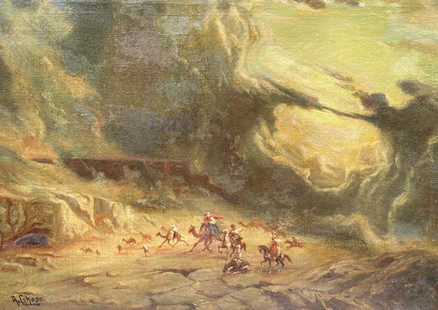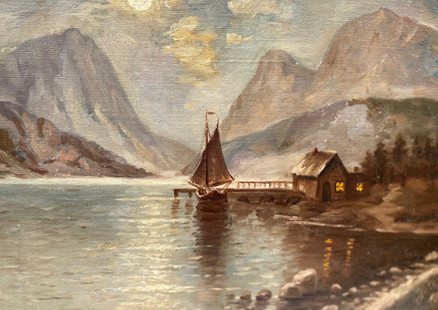
الفن
ART
“
In the process of development, however, it (art) must necessarily undergo certain changes in form and technique, even in spirit...The change must, therefore, be in the native expression, as well as in the material for assimilation.
“
– Ameen Rihani, “The Syrian in American Art,” The Syrian World, November 1930. Khayrallah Center Archive.
%20%2B%20AR%2C%20Cairo%2C%201922.jpg)

Assad Ghosn, Portrait of Naoum Mokarzel, c. 1904-1941.
Courtesy private collection.
Introduction
Amid the flourishing Arab American cultural life in the early twentieth century, amateur and professional artists, art dealers, critics, and businesses-turned-galleries formed an innovative creative hub that spanned the country.
At the core of this vibrant network was Arab American visual and material culture. Both within and outside the United States, artists’ works were an amalgamation of diasporic experience; a reflection of the many traditions, locations, and styles they engaged with at home (including Arab art) and throughout their journeys.
Jibran Khalil Jibran
"I am painting, or I am learning to paint. It will take me a long time to paint as
I want to, but it is beautiful to feel the growth of one’s own vision of things.”
– Jibran Khalil Jibran writing to Mary Haskell, Oct. 2, 1908
As the pioneer of Arab American art, Jibran Khalil Jibran’s artistic genius was first realized at the early age of twelve by educators and prominent local artists. By 1904, he had his first major exhibit in Boston, displaying his realism-infused sketches and drawings. On July 1, 1908, under the sponsorship of Mary Haskell, Jibran travelled to Paris to study oil painting at the Académie Julian in Paris, where he exhibited his famed painting, The Autumn (1910), at the Société Nationale des Beaux-Arts in 1910. He exhibited multiple paintings at the Union Internationale des Beaux-Arts later that same year.

Jibran Khalil Jibran, Self-Portrait, oil on Masonite, c. 1911. Telfair Museum of Art, Savannah, Georgia.
Click on image for more details
Selections of Jibran's Artworks




Marie Azeez El-Khoury
Marie Azeez El-Khoury, also known as “The Mother of Emeralds,” was an internationally renowned jewelry designer, art collector, member of the Metropolitan Museum of Art Board, and freelance writer living and working in Manhattan. Her unique and eye-catching gem designs were widely sought after and were featured in Vogue, The New Yorker, The Christian Science Monitor, Harper’s Bazaar, and other notable magazines. Her pieces were worn by high profile women, including ballet dancer Désirée Lubovska, Portia Grafton, and actresses Alice Brady and Mary Nash.
.jpeg)
Marie Azeez El-Khoury, Daily News, New York, August 21, 1938.
Selections of El-Khoury's Work
Click on image for more details. Scroll using left or right white arrows to see more designs.

Assad Ghosn
Early twentieth century portrait artist Assad T. Ghosn journeyed from Greater Syria in 1891 to study oil painting at the Accademia di Belle Arti di Roma in Rome, Italy. Upon his emigration to the U.S. in 1904, Ghosn opened a studio in Brooklyn before settling in Richmond, Virginia, specializing in oil paint portraits from both life studies and photographs. Over the course of his career, Ghosn was commissioned by state representatives, corporations, churches, and both prominent and community families on account of his painterly skill in realism and individual identity. He exhibited his many landscape and still-life paintings, portraits, and Oriental genre scenes in Italy, New York City, and at the Corcoran Galleries in Washington, D.C.
Portrait of Assad Ghosn and his wife, Sadie Gorayib, no date. Courtesy private collection.
Selections of Ghosn's Artworks

Jibran: The Artist

Jibran's Artistic Legacy
Selections of El-Khoury's Work
Click on image for more details. Scroll using left or right white arrows to see more designs.
Selections of Ghosn's Artworks
Click on image for more details
Click on image for more details















Color a Ghosn Painting
-
Select the color from the palette on the left by clicking on a swatch.
-
Click a space in the painting to fill it with that color.
-
Download your masterpiece when you finish!
-
Depending on your internet connection, the interactive may take a few seconds to load.
-
To scroll past the interactive, hold your mouse to the side.
Nicholas S. Macsoud
Nicholas Saleem Macsoud (March 7, 1884 - July, 1972, Zahlé, Lebanon) was a notable painter who established himself in Brooklyn, New York. Macsoud, who emigrated to New York in 1899, studied art at the National Academy of Design in New York and is known for his landscapes and skill as a miniaturist. Throughout his career, Macsoud was treasurer of the Brooklyn Society of Artists, president of the Brooklyn Society of Miniature Paintings, and was elected to the Salmagundi Club.

Nicholas Macsoud, The Brooklyn Daily Eagle, January 6, 1918.
Selections of Macsoud's Artworks
Click on image for more details

Emma Maloof
Though little in the archival record illuminates the details of her personal life, Emma Maloof’s distinction as a fashion designer is apparent throughout early women’s magazines and newspaper journals. Born in 1892 in Zahlé, modern-day Lebanon, Maloof’s educated, middle-class family emigrated to New York in 1894. Among her siblings was brother Alexander Maloof, the prominent musician and conductor. According to immigration records, her mother, Hanna, made a living to support the family doing “fancy needlework.” Exposure to the industry and having some access to the necessary capital to start a business could be reasons for Maloof’s entrance and prominence into the fashion industry.
Advertisement for bridal nylon tricot négligée and matching nightgown designed by Emma Maloof. Harper’s Bazaar, Vol. 85 Iss. 2886, May 1952.
Selections of Macsoud's Artworks
Click on image for more details



Selections of Maloof's work
Click on image for more details
Ameen Rihani
Ameen Rihani, who was a prominent Lebanese American intellectual, writer, and orator, was also a celebrated sketch artist and art critic. As a member of literary clubs and societies in New York, Rihani was surrounded by artists from across the globe, which may have inspired his own artistic pursuits. In 1915, Rihani met Bertha Case, an American artist whom he would later marry and through whom he was exposed to the European artistic influence of Henri Matisse, Pablo Picasso, and Paul Cézanne.
%20%2B%20%20AR%20by%20the%20American%20artist.jpg)
Portrait of Ameen Rihani by S.J. Woolf, 1920. Ameen Fares Rihani Collection, Khayrallah Center Archive.
Selections of Rihani's Artworks
Click on image for more details






.jpeg)
Esau J. Halow
Esau Joseph Halow (c. 1892-1935) was a prominent painter who emigrated with his family to the United States from Tripoli circa 1899. Initially arriving in Latrobe, Pennsylvania, Halow and his family later settled slightly east in Altoona, Pennsylvania where he attended public school, graduating from high school in 1916. After graduating, Halow worked briefly as a rug merchant, as his father had, and then buying and selling artworks. On July 28, 1918, Halow was sent to Fort Jackson for basic training in Columbia, South Carolina, where he worked as a painter in the camouflage department. After his service ended later that year, Halow moved to Philadelphia, then soon found his way to New York in the early 1920s where he studied art.
Esau Halow, April 18, 1935. Ameen Fares Rihani Collection, Khayrallah Center Archive.
Selections of Halow's Artworks
Click on image for more details



Arab American Women Artists
The present-day collection of mahjari objects reveals the frequent exclusion of women’s art within the archives and highlights their marginalization within the art world. While Marie Azeez El-Khoury and Emma A. Maloof prove to be exceptions, newspapers and magazine articles reveal fragments of the contributions made by Arab American women artists. For example, Missouri artist R.D. Zammer traveled nationally with the American Red Cross speaking of her humanitarian work and selling her artwork at local Elks Lodges to raise funds for the organization. Comparably, artist Amelia Johns, who was selected to design commercial posters for the Egyptian film Wedad (1936) American tour in 1938, was celebrated for her artistic talent in her hometown of Wilkes-Barre, Pennsylvania, but is virtually absent from the mainstream contemporary canon.

Movie poster for the Egyptian film Wedad (1936), starring Umm Kulthum. Designed by Amelia Johns, c. 1938. Wikimedia Commons and The Syrian Lebonite Voice c. 1938. Courtesy of the Southern Federation of Syrian Lebanese American Clubs.

Ameen Rihani, “The Syrian in American Art,” The Syrian World, November 1930 and Nicholas Macsoud’s The Holy Sepulchre--Jerusalem featured on the cover of The Literary Digest, April 7, 1928.
Art Criticism
One of the most prominent voices on Arab American art was Ameen Rihani. In addition to literature, Rihani published extensively on artists, various styles, and artworks from across the world. His critiques, which were published in The Syrian World as well as fine art magazines The International Studio and The Print Connoisseur, were published from the 1910s through the 1930s. Some of the artists he wrote about included Paul Dougherty (1877-1947), Edward Adam Kramer (1866-1941), Frederick Garrison Hall (1879-1946), William Oberhardt (1882-1958), Anders Zorn (1860-1920), William Simmons (1884-1948), Jonas Lie (1880-1940), and Esau Halow (1892-1935).
Exhibition Spaces
The turn of the twentieth century proved to be a period of transition for Arab American artists leaving behind vibrant art scenes to emigrate to the United States. Wanting to establish the validity and artistic value of their fine art, artists turned to their newly formed communities for support in exhibiting and promoting their artwork. Answering their call, restaurants, hotels, clothing stores, local shops, and small town galleries opened up their vacant windows and wall space for public display. For instance, Brooklyn-based artist Elias Howat exhibited his oil painting of famous Syrian operatic soprano Mme M. Kalzoom at the Lebanon Restaurant located on Washington St. in “Little Syria,” Manhattan. J. Sheber Shaddy took to the large display windows of the F.H. Rogers clothing store in Barre, Vermont to hang his Roman-inspired painting where “the attention of more than one passerby has been arrested by its presence in the window.”

Berenice Abbott, Exterior of Washington Street Lebanese restaurant, 1928, which displayed paintings by Lebanese artists in New York City. Metropolitan Museum of Art.
Selections of Rihani's Artworks
Click on image for more details






Selections of Halow's Artworks
Click on image for more details



EXPLORE EARLY
ARAB AMERICAN ART




















_edited.png)

